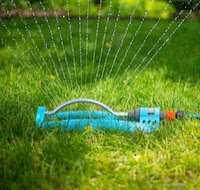Now is the time of year when lawns come out of dormancy – a time many gardeners eagerly await. This is also the time of year that we trade large heating bills for sometimes equally large water bills. As you consider your gardening plan this spring, why not resolve to use less water?
We use a lot of water
The US Environmental Protection Agency claims that, across the country, watering our landscaping accounts for nearly one-third of all residential water use, totaling nearly 9 billion gallons per day. In addition, some experts estimate that as much as 50 percent of water used for irrigation is wasted due to evaporation, wind, or runoff caused by inefficient irrigation methods and systems.

Start with the lawn
Sure, a lush, green lawn can increase a home’s curb appeal, but if you plan to stay put for a while, you can consider reducing your lawn’s size by replacing some areas with mulch or hardscaping. To maintain size, but reduce water usage, you can replant with a less thirsty variety of turfgrass and/or not cut your grass so short. Longer grass promotes deeper root growth, resulting in a more drought-resistant lawn, reduced evaporation, and fewer weeds.
Water more efficiently
Water your lawn before 10 a.m. for max efficiency. ThisOldHouse.comrecommends watering between 4 a.m. and 6 a.m. “At this cool time of day, it’s less likely the moisture will evaporate before your grassroots can absorb it from the soil,” they explain.
Plant early
Planting new plants in spring (vs. summer) gives them numerous advantages. Milder conditions are less harsh on the young leaves and buds, and lower temperatures require less water for the plants to get established.
Go native
Choosing plants native to your area is another way to save effort and water. Native, drought-resistant plants require less maintenance and less water once established and have the added benefit of providing habitats to beneficial pollinators and soil organisms.
Conserving water doesn’t mean you have to convert your yard into a rock quarry. Making some minor changes can reduce landscape water use but still leave your property looking beautiful and alive.